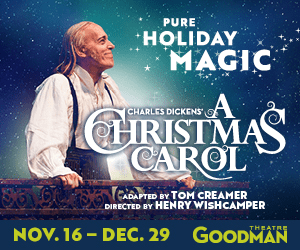
 [rating=5]Enthralling and electrifying, the show is just how you remember it—only better! For 42 years, the Goodman Theatre has thrilled Chicago audiences and visitors from around the world with its magical production of “A Christmas Carol.” This year, veteran director Henry Wishcamper has outdone himself. Watching this heartwarming performance of a misanthrope transformed, the ghost of Charles Dickens will have certainly proclaimed from the rafters, “Well done!”
[rating=5]Enthralling and electrifying, the show is just how you remember it—only better! For 42 years, the Goodman Theatre has thrilled Chicago audiences and visitors from around the world with its magical production of “A Christmas Carol.” This year, veteran director Henry Wishcamper has outdone himself. Watching this heartwarming performance of a misanthrope transformed, the ghost of Charles Dickens will have certainly proclaimed from the rafters, “Well done!”
In his twelfth season of playing Ebenezer Scrooge, Larry Yando remains superior in the role. He counts his money and is loath to recount his past. But with the insistence of the ghost of his former partner Jacob Marley (Kareem Bandealy) and the visitations of three spirits, the Ghost of Christmas Past (Molly Brennan), the Ghost of Christmas Present (Jasmine Bracey), and the Ghost of Christmas Future (Breon Arzell), Scrooge changes his entire outlook on life. His living nightmare is a 19th century account of a near death experience, with a life (and death) review and his subsequent return to his present existence on earth, where he can willfully make amends.
As this nasty, penny-pinching, and miserly man acts so genuinely and convincingly, with so much comedic body language, each of us cannot help but identify with him—even if we don’t hold his belief system. Or perhaps we do? Maybe that’s the whole point of the story: That some part of us is like Scrooge, and that we can become better people by means of watching his example. Moreover, how many of us have awoken from a nightmare and wondered if it were real, or if it had really happened? We may recognize the people in our dreams or not; but it might take a moment or two to realize that we are actually in the comfort of our bed with our cozy robe, slippers, and blanket—and familiar surroundings.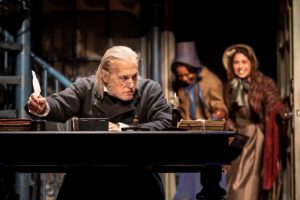
The spectacular actors in this one-of-a-kind performance are too many to name. However, special recognition must go to Thomas J. Cox, who plays Bob Crachit, and Paris Strickland, who plays Tiny Tim.
Words cannot express just how breathtaking the scenic design is. Kudos to Todd Rosenthal for his vivid, imaginative, well-crafted sets that flawlessly move on and off stage—and propel this meaningful and scary story. Especially magnificent is Scrooge’s house, with its huge, ornate, and empty bedroom, which contrasts with Bob Crachit’s humble, crowded, and small home, full of the warmth of family and Christmas joy. Making the main set askew by roughly five degrees east of vertical adds to the fright. Especially impressive is when the set retreats to give us the illusion that Scrooge and the first ghost are actually flying into the night. The painted scene before the curtain rises is that of London in the 1840s, which prominently features St. Paul’s Cathedral; this provides a good sense of place and nicely establishes the frame for the story.
Sound design by Richard Woodbury and lighting design by Keith Parham add to the audience’s disquieting agitation and stirs our emotions to a frenzy. Superb is not a strong enough word to describe all of this! Please note that there was one boy about eight or nine years old whom I overheard telling his mother during the intermission that he was scared. Some of the extraordinary special effects in the first act may be overwhelming for little ones; plus talk about death during the second act may be disturbing to them as well. A child’s level of maturity is something to keep in mind when bringing them to the show.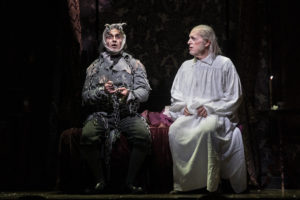
Costume designer Heidi McMath demonstrates her artistry in recreating the lovely clothes from the late 18th and early 19th centuries as well as conceptualizing the imaginative attire worn by the various spirits.
Musicians Justin Amolsch, Alison Tatum, Maddi Ruhl, and Malcolm Ruhl perform original music composed by Andrew Hansen. The light and airy instrumentals, frolicy dance numbers, and cheerful singing among the common-folk provide a festive atmosphere—in blatant contrast with the angst that Scrooge is going through. A shout-out must be made here to the Benet Academy Madrigal Singers, who started out the evening by singing Christmas carols from the mezzanine of the lobby as theatre-goers waited for the house to open.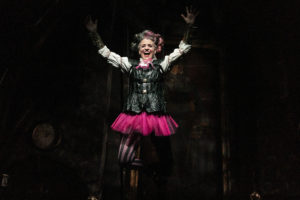
The timeless quality of Charles Dickens’ original tale is delightfully enhanced in this adaptation by Tom Creamer, who includes several historical references within the show. For example, early on, Scrooge insists that debtors’ prisons are a good and necessary thing. But in real life, Dickens was an advocate for prison reform. His father had been once sent to Marshalsea Prison for failing to pay his creditors; later, when the Fleet Prison was closed in 1842, Dickens learned that debtors had been incarcerated there for over thirty years. Also in two spots during the play, Scrooge advocates thinning out the ranks of the poor when he refers to “surplus population.” This is a reference to Thomas Robert Malthus, who wrote in the late 18th century that unending poverty, malnutrition, and disease would eventually result when an increasing population outstripped the available food supply. Without constraints on population growth, hardship would occur for all. When Dickens published “A Christmas Carol” in 1843, his book was meant to be as much of an affirmation of compassion, generosity, and religion as it was meant to be a refutation of Malthus’s gloomy demographic prediction of death and destruction.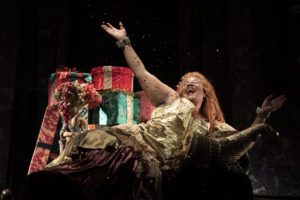
With a beautifully crafted script combined with phenomenal acting, stagecraft, sound effects, music, and all the rest, this production of Dickens’ classic is one of the most unforgettable performances you’ll see. It inspires us to be our better selves. We learn that money is not the measure of everything. Above all, the underlying message is that the secret of life is not how much you can take from this world but how much you can give to it—and to others. Treat yourself to this impressive show, a staple of Chicago theatre! Make it a part of your holiday tradition. It’s perfection itself!
“A Christmas Carol” is playing at the Goodman Theatre (in the Albert Theatre), 170 N. Dearborn, Chicago, through December 29, 2019.
Tickets are $40 – $144, subject to change, and are available at GoodmanTheatre.org/Carol, by phone at 312-443-3800, by fax at 312-443-3825, or at the box office, 170 N. Dearborn.
Performances are:
Thursdays – 7:00 p.m.
Fridays – 7:30 p.m.
Saturdays – 2:00 p.m. and 7:30 p.m.
Sundays – 2:00 p.m. and 6:30 p.m.
Additional performances:
Wednesday, December 4 – 11:00 a.m.
Wednesday December 11 – 12:00 p.m.
Thursday, December 12 – 12:00 p.m.
Tuesday, December 17 – 7:00 p.m.
Monday, December 23 – 2:00 p.m.
Tuesday, December 24 – 2:00 p.m.
Thursday, December 26 – 2:00 p.m.
Accessible performances:
Touch Tour and Audio Described Performance – Saturday, December 7 – 12:30 p.m. – A presentation detailing the set, costume and character elements is followed by a performance in which the action/text is audibly enhanced for patrons via headset.
Open Captioned Performance – Sunday, December 8 – 2:00 p.m.
ASL Interpreted Performance – Saturday, December 14 – 2:00 p.m.
For more information, visit GoodmanTheatre.org/Access
Spanish Captioned Performance – Thursday, December 26th at 7:00 p.m.
A limited amount of tickets ($35) for the Spanish-translated performance are available with promo code SPANISH at GoodmanTheatre.org/Spanish-Captioned-Performance.
Student $10 day-of tickets; limit four, with Valid student ID (promo code 10TIX0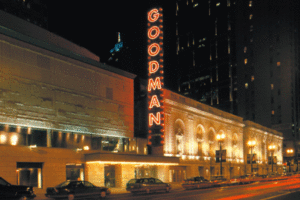
Group sales are available for parties of 10 or more, contact 312-443-3820.
To see what others are saying, visit www.theatreinchicago.com, go to Review Round-Up and click at “A Christmas carol”.

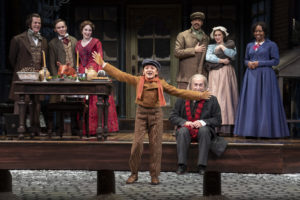


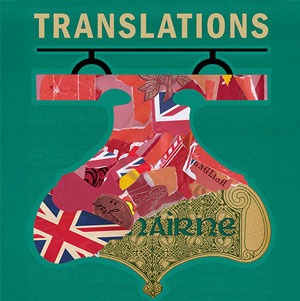
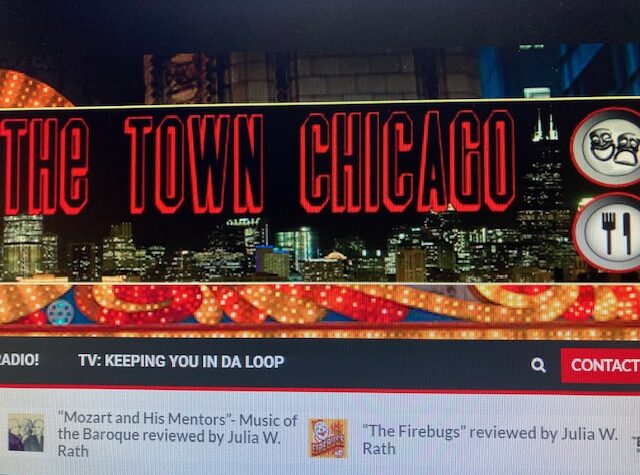
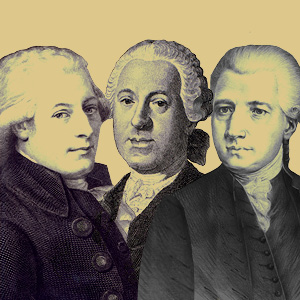
More Stories
“Translations”
“The Firebugs” reviewed by Julia W. Rath
“The Book of Grace” Al Bresloff with another from Paul LIsnek